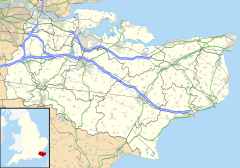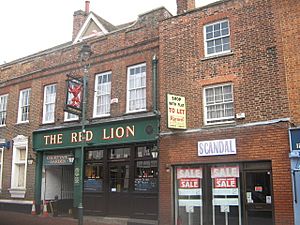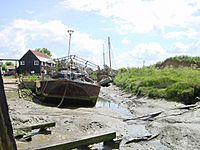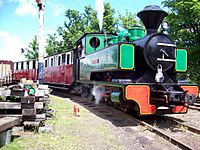Sittingbourne facts for kids
Quick facts for kids Sittingbourne |
|
|---|---|
| Industrial town | |
 Sittingbourne High Street |
|
| Population | 54,392 (2021 Census) |
| OS grid reference | TQ905635 |
| District | |
| Shire county | |
| Region | |
| Country | England |
| Sovereign state | United Kingdom |
| Post town | SITTINGBOURNE |
| Postcode district | ME9, ME10 |
| Dialling code | 01795 |
| Police | Kent |
| Fire | Kent |
| Ambulance | South East Coast |
| EU Parliament | South East England |
| UK Parliament |
|
Sittingbourne is a town in Kent, southeast England. It is about 17 miles (27 km) from Canterbury and 45 miles (72 km) from London. The town is located next to the the Swale, which is a strip of sea separating mainland Kent from the Isle of Sheppey.
Sittingbourne became an important stop after Thomas Becket died in 1170. It was a good resting place for people traveling between London, Canterbury, and Dover. Today, train lines connect Sittingbourne to London Victoria station and St Pancras International, with journeys taking about an hour.
Contents
What's in a Name? The History of Sittingbourne
The name Sittingbourne comes from an old way of describing its location. The town's name means "the hamlet by the bourne" or "small stream". This refers to a small stream that runs underground in parts of the town.
In old records from 1274–5, Sittingbourne was called "Sydingeburn". These records show that people paid a small amount of money to the king for using land in the town.
Ancient Times: Romans in Sittingbourne

People lived in the Sittingbourne area even before 2000 BC. They were farming and trading tribes. They lived inland to stay safe but close enough to reach the sea at Milton Creek.
In AD 43, the Romans came to Kent. They built Watling Street to make travel faster between London and Dover. This road went right through Sittingbourne. The nearby port of Milton Regis became a Roman center. Many Roman villas have been found there. Sittingbourne itself stayed a small village during Roman times.
Many Roman objects were found in the 1800s by brick makers. They dug up topsoil to make bricks and uncovered these ancient items. A banker named George Payne helped save these finds and wrote about them in 1893.
Middle Ages: A Popular Stopping Place
Sittingbourne was not mentioned in the Domesday Book of 1086. However, after the murder of Archbishop of Canterbury, Thomas Becket in 1170, many pilgrims traveled to Canterbury Cathedral. Sittingbourne became a very useful place for these travelers to stop and rest.
The town is even mentioned in Chaucer's famous book, The Canterbury Tales. One character talks about telling stories before they reach "Sidyngborne".
The local church, St Michael's, was built in the 1200s. At that time, Sittingbourne's High Street had many pubs and places for travelers to stay. The Lyon, which is now called the Red Lion, hosted King Henry V of England after his victory at the Battle of Agincourt. King Henry VIII also visited Sittingbourne in 1522 and 1532.
In 1708, the Rose Inn was built. It was once a private house. People said it was one of the most beautiful inns in the whole country. In 1825, the future Queen Victoria and her mother stayed overnight at the Rose Inn.
Industrial Revolution: Railways and Factories
When the railway arrived in 1858, Sittingbourne changed. It became less about markets and inns. Instead, it grew into a center for making things needed in London. The town produced bricks and paper using its local clay and other materials.
World War I: Air Raids Over Sittingbourne
During the First World War, Sittingbourne and the areas around it were often attacked by German airships called Zeppelins and airplanes. The Germans used the town as a landmark to help them find their way to London.
The first German plane visited on Christmas Day 1914. Another plane bombed Sittingbourne on January 16, 1915. About 100 air-raid warnings were sounded in Sittingbourne during the war. Anti-aircraft guns were made stronger in 1917.
One of the biggest raids happened on May 19, 1918. German planes called Gothas flew over the town. British planes fought back strongly. The local newspaper reported that one German plane caught fire and crashed.
A brave soldier from Sittingbourne, Donald John Dean, was given the Victoria Cross for his actions in France in 1918. After the war, the Kent Association for the Blind was started in Sittingbourne in 1920 to help soldiers who had lost their sight.
Economy: Making Things in Sittingbourne
Sittingbourne has a lot of clay, which is good for making bricks. It also has plenty of chalk, which is rare in many parts of Europe. These natural resources led to important industries like water transport, paper making, and cement production. These industries are still important in the area today.
Brickmaking: Building London with Sittingbourne Bricks
In 1870, over 2,600 men worked in the brick and tile industry in Sittingbourne. This was more than any other brick-making area in England. Brickmaking continued in the town until the mid-1900s. The bricks used for the 3.45-mile (5.55 km) London Bridge – Greenwich Railway Viaduct were all made in Sittingbourne. They were then moved to London by barges.
Bargebuilding: Transport on Water
Barges were flat-bottomed boats used to move raw materials and finished goods to London and other places. Sittingbourne was perfect for this, and a successful industry for building barges grew in Milton Creek.
Sittingbourne became an important port during the Industrial Revolution. Kent's farm products were sent to London markets from here. Over 500 types of barges were built in the area.
After World War II, the barge-building business slowed down. By 1965, only one yard, Burley yard, was still repairing barges. This led to the creek becoming muddy and unused.
In 1968, the Dolphin Sailing Barge Museum Trust started. They leased the old yard to save and restore barges. The museum was sadly destroyed by fire in 2008. There are plans to move it to a new location.
A bronze statue of a bargeman in the town center reminds everyone of Sittingbourne's strong connection to water transport.
Paper Making: From Trees to Newspapers
Paper making began in Sittingbourne in 1708. By 1820, Sittingbourne Mill was a large paper factory. In 1863, Edward Lloyd, who owned the Daily Chronicle newspaper, bought the mill. He used straw from local farms and a plant called esparto to make paper. This was cheaper than cotton.
To make paper faster, Lloyd's son built a wharf (a loading dock) on Milton Creek in 1904. A horse-drawn railway was built to carry materials to the mill. In 1906, the first steam train, called Premier, started running on what is now the Sittingbourne & Kemsley Light Railway. This railway was extended to a new dock in 1913.
By 1912, Sittingbourne Paper Mill was the biggest producer of newsprint (paper for newspapers) in the world. It had 1,200 employees and 17 machines, making over 2,000 tons of paper each week for newspapers in London.
In 1924, Lloyd's son built a new factory in Kemsley and a special village for the workers. The Sittingbourne Mill closed in 2006, with the last paper made in January 2007.
Education in Sittingbourne
Sittingbourne has several primary schools for younger children. For older students, the main secondary schools are Fulston Manor School, The Sittingbourne School, and The Westlands School. There are also two grammar schools: Borden Grammar School for boys and Highsted Grammar School for girls. Students who want to go to a grammar school take a test called the Kent Test (11+).
Sittingbourne also has an Adult Education Centre and an Adult Skills center for older students and adults. In 2015, a technical college for students aged 16 and over opened in the town.
Getting Around: Transport in Sittingbourne

Sittingbourne has a railway station that is about 44 miles (71 km) from London Victoria. It is on the Chatham Main Line. The station is managed by Southeastern. Regular trains go to London Victoria, London St Pancras International (using a high-speed line), The Medway Towns, Canterbury, Dover, and Ramsgate. There is also a train that runs every hour to Sheerness-on-Sea.
Most bus services in Sittingbourne are run by Chalkwell Coaches. These buses go to places like Chatham, Gillingham, Rainham, and Kemsley. Other bus companies like Arriva Southern Counties and Stagecoach South East also serve the town, connecting it to Maidstone, Faversham, and Canterbury. All bus services use the Sittingbourne Bus Hub, which opened in 2019.
Sittingbourne is located between the important port of Dover and London. The first major road here was Watling Street, built by the Romans. Today, this is the A2 main road. The M2 motorway goes around the south of the town. The A249 road passes the town on the west, connecting Maidstone and Sheerness.
Sittingbourne and Kemsley Light Railway: A Historic Train Ride
The Sittingbourne and Kemsley Light Railway is a preserved railway that used to serve the paper mills. In 1965, it was decided that using the railway was too expensive, and trucks were used more often. So, in 1969, the railway was given to a group called the Locomotive Club of Great Britain. They wanted to save it and run it as a heritage railway.
Today, this railway is a popular tourist attraction in Sittingbourne. It is also the only way to get to the annual Sittingbourne Beer Festival. However, the railway has been at risk of closing since 2008, when the land was sold to a property developer.
Media: News and Entertainment
Television News
Local television news for Sittingbourne comes from BBC South East Today and ITV News Meridian.
Radio Stations
Local radio stations for Sittingbourne include BBC Radio Kent, Heart South, and 106.9 SFM. SFM started broadcasting in 2012 and provides local community radio services.
Newspapers
The local newspapers are the KM Sittingbourne Messenger and the mid-week edition, KM Sittingbourne News Extra. Both are published by the KM Group. Another local newspaper, the East Kent Gazette, closed down in 2011 after being the town's news source since 1856.
Notable People from Sittingbourne
- Wilfred Andrews (1892-1975), a former Chairman of the RAC.
- Roger Moate (1938–2019), a Conservative politician.
- Eileen Greenwood (1915–2008), who was the principal of Sittingbourne College of Education.
- Dave Whitcombe, a former professional darts player.
- Shane Byrne, a six-time British Superbike Champion.
Sports in Sittingbourne
Sittingbourne has a senior football team called Sittingbourne F.C., also known as "The Brickies". They play their games at Woodstock Park.
The town has two hockey clubs: Sittingbourne Hockey Club and Gore Court Hockey Club.
Motorcycle speedway racing has been held near Sittingbourne for many years. The track was first used for training. Since 1994, the Sittingbourne Crusaders have competed there. Today, the track is still a popular place for speedway training for riders from all over the country.
Sittingbourne is also home to Bayford Meadow's Kart Circuit. This is a large karting track set on 12 acres of land.
Sittingbourne Rugby Club was started in 1976. They have several men's teams and also active junior and mini sections for younger players.
Twin Towns
Sittingbourne is twinned with:
- Ypres, Belgium (since 1964)
Images for kids
See also
 In Spanish: Sittingbourne para niños
In Spanish: Sittingbourne para niños






